The iPhone 5s Review
by Anand Lal Shimpi on September 17, 2013 9:01 PM EST- Posted in
- Smartphones
- Apple
- Mobile
- iPhone
- iPhone 5S
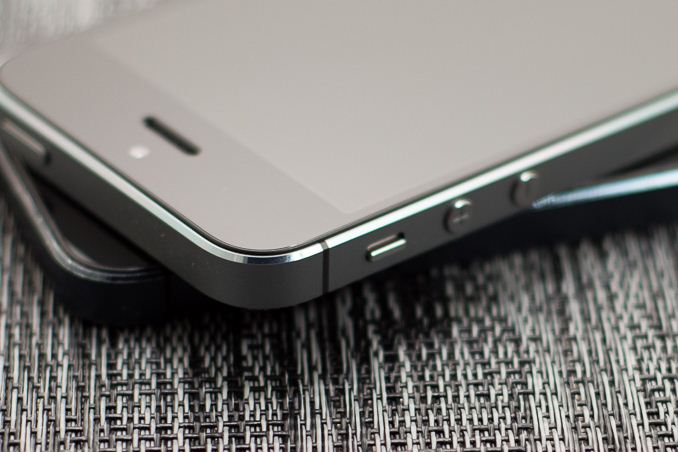
For much of the iPhone's life Apple has enjoyed a first-mover advantage. At the launch of the first iPhone, Steve Jobs expected the device and OS would give it a multi-year head start over the competition. Indeed that's how the market played out. Although Android was met with some early success, it wasn't until well after the launch of the first Android devices that we started seeing broad, mainstream acceptance of the platform. The iPhone bought Apple time, and together with the iPad it brought Apple a tremendous amount of profit over the years. The trick of course is turning a first-mover advantage into an indefinitely dominant market position, a difficult task when you're only making one device a year.
Today we find Apple in a very different position. The iPhone is still loved by a very loyal customer base, but the competition is much stronger than it was back in 2007. The modern smartphone market has also evolved. When Apple introduced the original iPhone with its 3.5" display, Steve called it "giant" on stage. Today even HTC's One mini ships with a 4.3" display.
Last year we saw Apple begin to address the changing landscape with the iPhone 5. The 5 saw Apple moving to a thinner, lighter chassis with much better internals and a significantly larger display. While there is market demand for Apple to do the same again, and move to an even larger display, there are some traditions Apple is sticking to. In this case, it's the tradition of the S-update.
The iPhone 5s continues Apple’s tradition of introducing a performance focused upgrade for the last year of any new chassis design. The first time we encountered an S-update was with the 3GS, which took the iPhone away from its sluggish ARM11 roots and into the world of the Cortex A8.
The next S-upgrade came with the iPhone 4S: Apple’s first smartphone to use a dual-core SoC. At the time I remember debate over whether or not a performance upgrade alone was enough to sell a new device, especially one that didn’t look any different. I’m pretty much never happy with the performance I have, so I eagerly welcomed the new platform. Looking back at the iPhone 4 vs. 4S today, I’d say the investment was probably worth it. In preparation for this review I threw iOS 7 on every iPhone that would support it, dating back to the iPhone 4. In my experience, the 4 is a bit too slow running iOS 7 - the 4S really should be the minimum requirement from a performance standpoint.
That brings us to the iPhone 5s, the third in a list of S-upgrades to the iPhone platform. Like the S-devices that came before it, the iPhone 5s is left in the unfortunate position of not being able to significantly differentiate itself visually from its predecessor. This time around Apple has tried to make things a bit better by offering the 5s in new finishes. While the iPhone 5 launched in silver and black options, the 5s retains silver, replaces black with a new space grey and adds a third, gold finish.
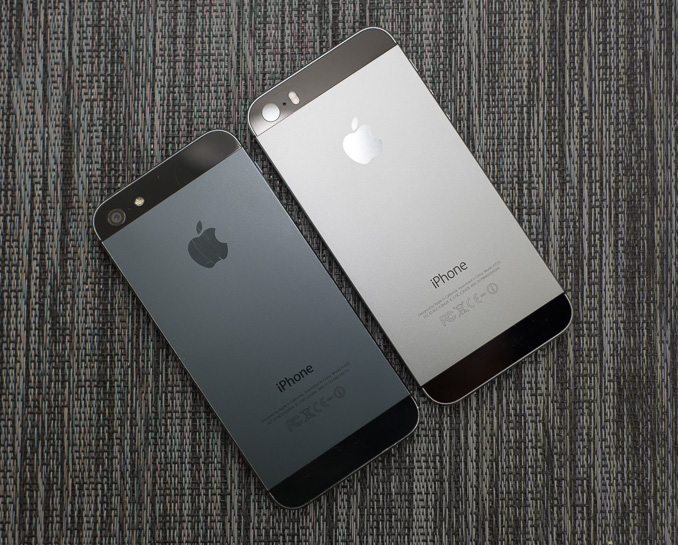
old black iPhone 5 (left) vs. new space grey iPhone 5s (right)
I was sampled a space grey iPhone 5s, which worked out well given my iPhone 5 was black. The new space grey finish is lighter in color (truly a grey rather than a black) and has more prominently colored chamfers. The move to a lighter color is likely to not only offer a little bit of visual differentiation, but also to minimize the appearance of scuffs/scratches on the device. My black iPhone 5 held up reasonably well considering I carry it without a case, but there’s no denying the fact that it looks aged. Interestingly enough, I never really got any scratches on the back of my 5 - it’s the chamfers that took the biggest beating. I have a feeling the new space grey finish will hold up a lot better in that regard as well.
The addition of a gold option is an interesting choice. Brian and I saw the gold iPhone up close at Apple’s Town Hall event and it really doesn’t look bad at all. It’s a very subtle gold finish rather than a gaudy gold brick effect. I think gold is likely the phone I’d opt for simply because it’d be very different than everything else I have, but otherwise space grey is probably the best looking of the three devices to me.
Along with the new finishes come new leather cases to protect the 5s. These cases are designed and sold by Apple, and they are backwards compatible with the iPhone 5 as well. Apple calls them leather cases but I'm not entirely sure if we're talking about real leather here or something synthetic. Either way, the new cases feel great. They've got a very smooth, soft texture to them, and are lined with a suede like material.
The new cases don't add a tremendous amount of bulk to the device either. The cases are available in 5 different colors and retail for $39:
I was sampled a beige case and have been using it non-stop for the past week. I really like the case a lot and it did a great job protecting the 5s over the past week while I was traveling. I took all of the photos of the review device after I returned home from traveling, but thanks to the case the device still looked as good as new. If you're considering one of these cases you might want to opt for a darker color as the edges of my case started to wear from constantly pulling the phone out of my pockets:
If you're fine with the distressed leather look then it's not a concern, but if you're hoping to keep your case pristine you may want to look at other cases. If you want a more affordable & more rugged option, Brian turned me on to the Magpul Field case which should work perfectly with the iPhone 5s.
Since the 5s is an S-upgrade, the chassis remains unchanged compared to the iPhone 5. The 5s’ dimensions are identical to that of the iPhone 5, down to the last millimeter of size and gram of weight. Construction, build quality and in-hand feel continue to be excellent for the iPhone 5s. Despite the diet the iPhone went on last year, the 5/5s chassis is still substantial enough to feel like a quality product. I remember criticisms of the iPhone 5 at launch, saying that it felt too light. Now going back and holding an iPhone 4S, it feels like the very opposite is true - the 4S was too heavy
The iPhone 5s design remains one of the most compact flagship smartphones available. The move to a 4-inch display last year was very necessary, but some will undoubtedly be disappointed by the lack of any further progress on the screen dimension front. A larger display obviously wasn’t in the cards this generation, but I have a strong suspicion Apple has already reconsidered its position on building an even larger iPhone. Part of the problem is the iPhone’s usable display area is very much governed by the physical home button and large earpiece/camera area at the top of the device. Building a larger iPhone that isn’t unwieldy likely requires revisiting both of these design decisions. It’s just too tall of an order for a refresh on the same chassis.
Brian often talks about smartphone size very much being a personal preference, and for many the iPhone 5 continues to be a good target. If you fall into that category, the 5s obviously won’t disappoint. Personally, I would’ve appreciated something a bit larger that made better use of the front facing real estate. The 5s’ width is almost perfect for my hands. I could deal with the device being a little larger, with the ideal size for me landing somewhere between the iPhone 5 and the Moto X.
It remains to be seen the impact display size has on iPhone sales. Anecdotally I know a number of die hard iPhone users who simply want a larger display and are willing to consider Android as a result. I still believe that users don’t really cross shop between Android and iOS, but if Apple doesn’t offer a larger display option soon then I believe it will lose some users not because of cross shopping, but out of frustration.
As a refreshed design, the iPhone 5s carries over all of the innovations we saw in the 5 last year. The iPhone 5s features the same Lightning connector that debuted on the iPhone 5, and has since been extended to the iPad lineup as well as the new iPods.
As with all other S-upgrades, the biggest changes to the iPhone 5s are beneath the aluminum and glass exterior. The 5s’ flagship feature? Apple’s new A7 SoC. The A7 is the world's first 64-bit smartphone SoC, and the first 64-bit mobile SoC shipping in a product (Intel’s Bay Trail is 64-bit but it won’t ship as such, and has yet to ship regardless). In addition to the new 64-bit SoC Apple upgraded both cameras in the iPhone 5s and added a brand new fingerprint sensor called Touch ID. Of course the iPhone 5s is one of the first new iPhones to ship with iOS 7 from the factory.
| Apple iPhone 5 | Apple iPhone 5c | Apple iPhone 5s | |
| SoC | Apple A6 | Apple A6 | Apple A7 |
| Display | 4-inch 1136 x 640 LCD sRGB coverage with in-cell touch | ||
| RAM | 1GB LPDDR2 | 1GB LPDDR3 | |
| WiFi | 2.4/5GHz 802.11a/b/g/n, BT 4.0 | ||
| Storage | 16GB/32GB/64GB | 16GB/32GB | 16GB/32GB/64GB |
| I/O | Lightning connector, 3.5mm headphone | ||
| Current OS | iOS 7 | ||
| Battery | 1440 mAh, 3.8V, 5.45 Whr | 1507 mAh, 3.8V, 5.73 Whr | 1570 mAh, 3.8V, 5.96 Whr |
| Size / Mass | 123.8 x 58.6 x 7.6 mm, 112 grams | 124.4 x 59.2 x 8.97 mm, 132 grams | 123.8 x 58.6 x 7.6 mm, 112 grams |
| Camera |
8MP iSight with 1.4µm pixels Rear Facing 1.2MP with 1.75µm pixels Front Facing |
8MP iSight with 1.4µm pixels Rear Facing 1.2MP with 1.9µm pixels Front Facing |
8MP iSight with 1.5µm pixels Rear Facing + True Tone Flash 1.2MP with 1.9µm pixels Front Facing |
| Price | $199 (16GB), $299 (32GB), $399 (64GB) on 2 year contract | $99 (16GB), $199 (32GB) on 2 year contract | $199 (16GB), $299 (32GB), $399 (64GB) on 2 year contract |
The iPhone 5s also breaks with tradition in a couple of ways. The 5s is the first iPhone in recent history to not be offered up for pre-order. Apple expects demand for the iPhone 5s to severely outstrip supply, and as a result won't be accepting pre-orders on the 5s.
The other big change is what happens to the previous generation iPhone. In the past, Apple would discount the previous generation iPhone by $100 on-contract and continue to sell those devices at low capacity points. A two-generation old iPhone was often offered for free on-contract as well. This time, the iPhone 5s replaces the iPhone 5 at the high end, but the iPhone 5 ceases production. Instead, the 5 is replaced with a cost reduced version (the iPhone 5c). As the glass & aluminum iPhone 5/5s chassis likely doesn't scale well in price, coming up with a new polycarbonate design for slightly lower price points makes sense. I have written a separate piece on the iPhone 5c as I have more than enough to talk about with the iPhone 5s in this review.
I'll start with the big ticket item: Apple's 64-bit A7 SoC.


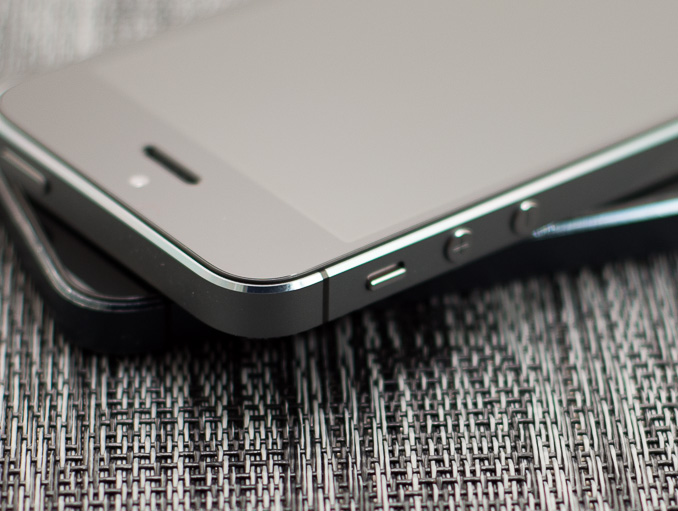
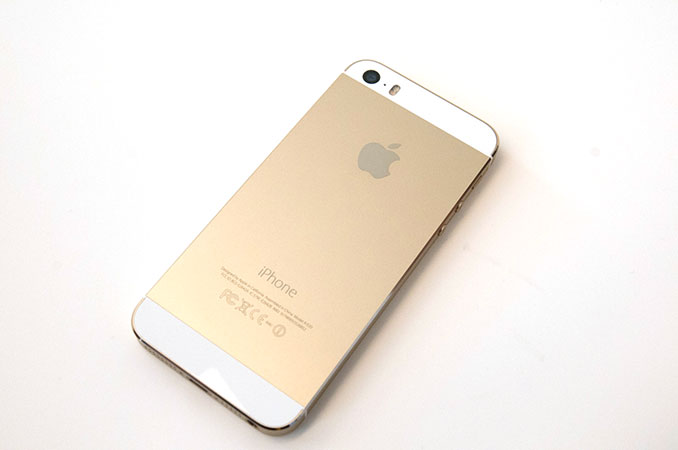
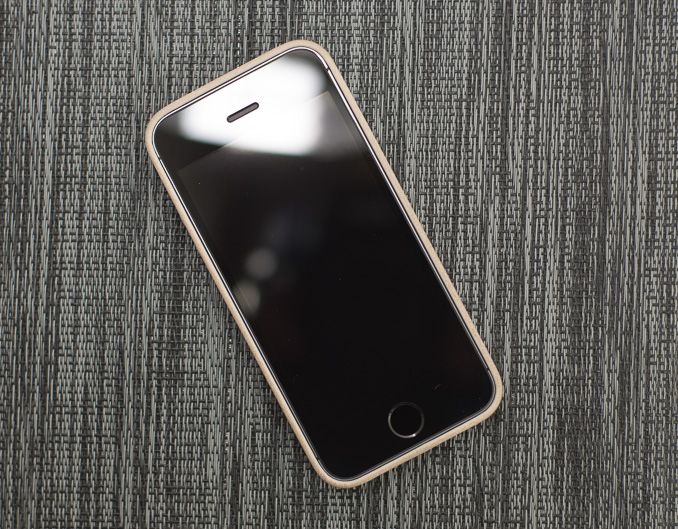
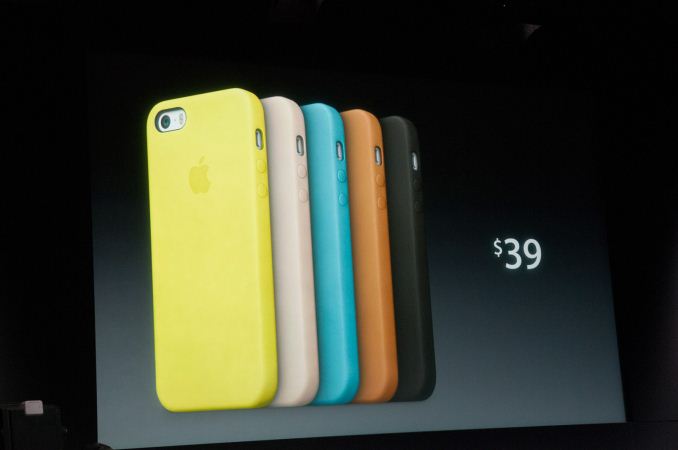
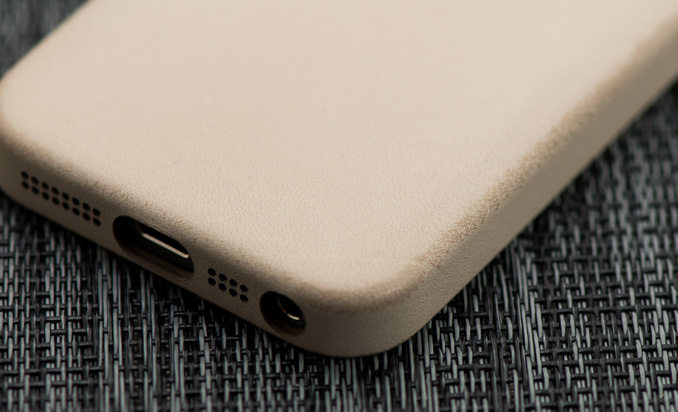
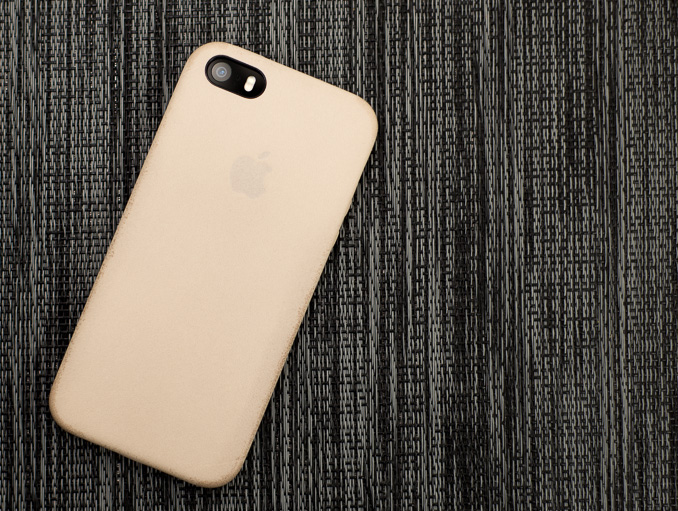








464 Comments
View All Comments
CyberAngel - Thursday, September 19, 2013 - link
Hurray!name99 - Wednesday, September 18, 2013 - link
I imagine he would say "I heard exactly the same shit about the A6 and how it couldn't possibly be as good as I claimed. Come back when you have NUMBERS to back up your complaints."monaarts - Wednesday, September 18, 2013 - link
You are mistaking a more natural transition to a 64-bit mobile world with a "PR stunt." Yes, Android will probably make a huge jump and switch to 64-bit and include 8GB of memory, or something crazy like that, but will only add to fragmentation they are already burdened with. However, Apple is trying to avoid that by building steps that lead to where they eventually want the iPhone to go.ddriver - Wednesday, September 18, 2013 - link
The PC market is fragmented as well, but is still goes, doesn't it? Surely, as a bigger ecosystem, android will be slower to adopt changes. But HPC doesn't really make sense in a phone, that is why most ARM chip vendors are focusing on server v8 chips and infrastructure, which will be more lucrative than consumer electronics. v8 is the future, no doubt about it, but apple has no other winning hand besides offering v8 a little too early, knowing they can make up for the cost of the premature transition with profit margins other manufacturers cannot dream of asking for the same hardware. Surely, other brands have their fanboys too, but nowhere nearly as fanatically devoted and eager to "just take my money".tbrizzlevb - Wednesday, September 18, 2013 - link
I've never had any problem with this "fragmentation" that you cut and pasted from somewhere. How exactly has that kept you from buying Android? Do you normally keep your phone for 5 years or more? I'd be willing to bet you aren't using an iPhone 3 right now.. If you upgrade your phone every few years anyways, what do you care if the first generation Droid doesn't run the latest OS update?AaronJ68 - Wednesday, September 18, 2013 - link
The fact that there was never an iPhone 3 might have something to do with that.CyberAngel - Thursday, September 19, 2013 - link
As a programmer I say there is a HUGE fragmentation problem with all the Androids.I code for Jelly Beans only and I do have an "old" 4.0 mono CPU device for testing the lag.
Focher - Wednesday, September 18, 2013 - link
You lost me when you used the phrase "apple fanboys" and "declining sales". You don't seem to understand the difference between market share versus unit sales.ddriver - Wednesday, September 18, 2013 - link
So you must have taken "apple fanboys" personally, and understandably "declining sales" in a context regarding apples conflicts you. Like all other vendors, apple sales drop, thus the periodic refreshes, which do need their selling points, this time around it is v8. In the past, apple resorted to similar strategies, like making exclusive deals, purchasing the entire initial batches of new generation parts, and again making up for the cost of this "innovation" with their profit margins.I don't recall any other brand which pushed kids to selling their organs, do you? If that is not fanatical fanboyism, I don't know what it is...
akdj - Thursday, September 19, 2013 - link
Weird---seems to me EVERY time an iPhone is released, it sells MORE than the previous version FASTER! In fact, it's never been surpassed by another electronic item in history...and it's sales continue to climb. News Flash! Android (High end; S4/Note/HTC 1/XPeria) also sell @ a premium and almost @ the exact price of Apple's handsets. The rest of your post is nonsense. It's not just Anand's site and review praising the performance of the A7---it's ubiquitous. Is Apple paying Ars? TechCrunch? MacRumors? WSJ? Engadget? CNet?Dude---this is one HELL of an SoC. It's so much MORE than a 64bit chess match. A company licensing and building from the ground up a CPU/GPU/IPU that matches their OS and allows the tools to developers (For Free!) in XCode so the transition is seamless! The speed of this chip is awesome. Setting themselves up early is smart---the iPad release is imminent and has competition from both sides...Microsoft and Android. With a significantly larger 'body' and area to allow for more RAM...and future releases of other ARM based products, Apple is making in-roads within the mobile sector that ONLY bozos that cherish other brands, OEMs, or otherwise have some weird bone to pick with Apple can't realize. Mind blowing. I'm brand agnostic---use OSx, Windows and even own a couple of Android devices....but to me as dismissive as you are about the A7s build and putting it in a product the size of a pack of smokes is about as silly and should I say 'ignorant' a stance as I've seen in a long LONG time.
This move by Apple is HUGE. Moore's law now attributed to mobile. Still a dual core. Still 1GB of RAM (albeit DDR3 vs DDR2)---yet doubling, tripling, sometimes quadrupling performance of the other 'off the shelf' SoCs on the market that other OEMs are using. It's no secret---Apple has been hiring and head hunting chip designers from Intel and AMD for some time now. These guys and gals are some of the brightest minds on earth....but you've got it all figured out and somehow Anand's been blinded by the conspiracy---as has EVERY other reviewer on the 'net.
Un-Believable.
J